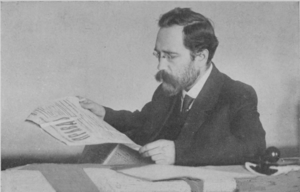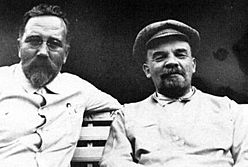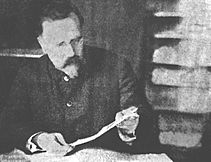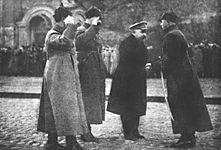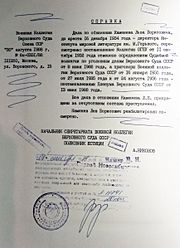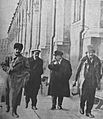Lev Kamenev facts for kids
Quick facts for kids
Lev Kamenev
|
|
|---|---|
|
Лев Каменев
|
|
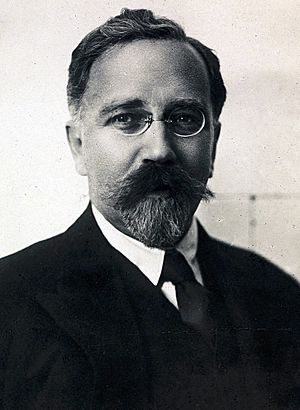
Kamenev c. 1920s
|
|
| Deputy Chairman of the Council of People's Commissars of the Soviet Union | |
| In office 6 July 1923 – 16 January 1926 |
|
| Premier | |
| Director of the Lenin Institute of the Central Committee | |
| In office 31 March 1923 – 1926 |
|
| Preceded by | Post established |
| Succeeded by | Ivan Skvortsov-Stepanov |
| Chairman of the Central Executive Committee of the All-Russian Congress of Soviets | |
| In office 9 – 21 November 1917 |
|
| Preceded by | Nikolai Chkheidze |
| Succeeded by | Yakov Sverdlov |
| Full member of the 8th, 9th, 10th, 11th, 12th, 13th Politburo | |
| In office 8 March 1919 – 1 January 1926 |
|
| In office 10 October – 29 November 1917 |
|
| Candidate member of the 14th Politburo | |
| In office 1 January – 23 October 1926 |
|
| Full member of the 6th, 7th, 8th, 9th, 10th, 11th, 12th, 13th, 14th Central Committee | |
| In office 17 January 1912 – 14 November 1927 |
|
| Personal details | |
| Born |
Leo Rosenfeld
18 July [O.S. 6 July] 1883 Moscow, Russian Empire |
| Died | 25 August 1936 (aged 53) Moscow, Russian SFSR, Soviet Union |
| Cause of death | Execution by firing squad |
| Citizenship | Soviet |
| Nationality | Russian |
| Political party |
|
| Spouses |
|
| Alma mater | Moscow State University |
Lev Borisovich Kamenev (born Leo Rozenfeld; 18 July 1883 – 25 August 1936) was an important Bolshevik revolutionary and a leading Soviet politician. He was born in Moscow to parents who were also involved in politics.
Kamenev joined the Russian Social Democratic Labour Party (RSDLP) in 1901. He took part in the 1905 Russian Revolution, which was not successful. In 1908, he moved abroad and became a close friend of Vladimir Lenin, another exiled revolutionary. He was arrested in 1914 and sent to Siberia. However, he was freed during the February Revolution of 1917, which ended the rule of the Tsar.
In 1917, Kamenev briefly served as a leader in Soviet Russia. He disagreed with Lenin's plan for an armed uprising during the October Revolution. Despite this, he remained powerful after the government fell. In 1919, he became a full member of the first Politburo, a key political group.
When Lenin was very ill in 1923–24, Kamenev became the acting leader of the Soviet Union. He formed a group with Grigory Zinoviev and Joseph Stalin. This group helped remove Leon Trotsky from power. Later, Stalin turned against Kamenev and removed him from leadership. Kamenev was arrested in 1935 and was a main defendant in the 1936 Moscow Trials. These trials marked the beginning of the Great Purge, a time when many people were arrested and executed. Kamenev was found guilty and executed on 25 August 1936.
Contents
Early Life and Revolutionary Path
Lev Kamenev was born in Moscow. His father worked on railways and his parents were involved in politics. Kamenev went to school in Tiflis, Georgia (now Tbilisi), and later attended Moscow University. He became involved in political activities there. In 1902, he was arrested, which stopped his formal education. From then on, he worked as a full-time revolutionary. He used the name Kamenev during this time.
In the early 1900s, he married Olga Bronstein, who was also a Marxist. She was the younger sister of Leon Trotsky. They had two sons together.
Joining the Social Democrats
Kamenev joined the Social Democrats in 1901. In 1902, he traveled abroad and met Russian social democratic leaders who were living in exile. One of them was Vladimir Lenin, and Kamenev became a close supporter of his. He also visited Paris and met the group that published the newspaper Iskra.
After attending a party meeting in London in March 1905, Kamenev returned to Russia. He took part in the Russian Revolution of 1905 in St. Petersburg.
Working with Lenin Abroad
In May 1907, Kamenev went back to London for another party meeting. He was elected to the party's Central Committee. But he was arrested when he returned to Russia. After being released in 1908, he and his family went abroad. They helped Lenin edit the Bolshevik magazine Proletariy.
After Lenin had a disagreement with another Bolshevik leader, Alexander Bogdanov, Kamenev and Grigory Zinoviev became Lenin's main helpers abroad. They helped Lenin remove Bogdanov and his followers from the Bolshevik group.
Attempts at Party Unity
In January 1910, different groups of the party tried to reunite. Kamenev and Zinoviev were not sure about this idea, but they agreed to try. Kamenev was added to the editorial board of Trotsky's newspaper Pravda. However, the attempts to unite the party failed in August 1910. Kamenev then left the newspaper's board.
After this, Kamenev continued to work for Proletariy. He also taught at a Bolshevik party school near Paris. In January 1912, Kamenev helped Lenin and Zinoviev convince Bolshevik leaders to separate from other groups.
Return to Russia and Exile
In January 1914, Kamenev was sent to St. Petersburg. His job was to lead the Bolshevik newspaper Pravda and the Bolshevik group in the Duma (parliament). In November, Kamenev was arrested. He was sent to Siberia in early 1915. He stayed there for two years until the February Revolution of 1917 freed him.
Before leaving Siberia, Kamenev suggested sending a telegram to the Tsar's brother, Mikhail. He wanted to thank him for refusing the throne. Later, Kamenev was so embarrassed by this action that he denied doing it.
On 25 March 1917, Kamenev returned from Siberia to St. Petersburg (which was renamed Petrograd in 1914). Kamenev and other Central Committee members, Joseph Stalin and Matvei Muranov, took control of the Bolshevik newspaper Pravda. Kamenev supported the new Russian Provisional Government and wanted to reunite with other socialist groups. After Lenin returned to Russia in April 1917, Kamenev at first disagreed with Lenin's strong anti-government ideas, but he soon supported Lenin.
October Revolution and Disagreements
Kamenev and Zinoviev had a disagreement with Lenin. They were against the Bolsheviks taking power in October 1917. On 10 October 1917, Kamenev and Zinoviev were the only two members of the Central Committee to vote against an armed revolt. They even published a letter saying they were against using force. This made Lenin very angry, and he wanted them removed from the party.
However, when the Bolsheviks, led by Adolph Joffe and Leon Trotsky, started the uprising, Kamenev and Zinoviev joined in. At the Second All-Russian Congress of Soviets, Kamenev was chosen as the Congress Chairman. He also became Chairman of the All-Russian Central Executive Committee, which was like being the head of state.
On 10 November 1917, after the Bolsheviks took power, a railroad union threatened a national strike. They wanted the Bolsheviks to share power with other socialist parties. Zinoviev, Kamenev, and their allies in the Bolshevik Central Committee argued that they had to negotiate. They thought a railroad strike would stop the government from fighting those still loyal to the old government.
Even though Zinoviev and Kamenev had support from most of the Central Committee for a short time, the anti-Bolshevik forces outside Petrograd quickly collapsed. This helped Lenin and Trotsky convince the Central Committee to stop the negotiations. Because of this, Zinoviev, Kamenev, and others resigned from the Central Committee on 4 November 1917. Kamenev also resigned from his head of state position. Lenin later called Zinoviev and Kamenev "deserters" and never forgot their actions.
Rise to Power and Opposition to Trotsky
In 1918, Kamenev became the chairman of the Moscow Soviet. Soon after, he became Lenin's Deputy Chairman of the government. In March 1919, Kamenev was elected as a full member of the first Politburo. His friendship with his brother-in-law Trotsky became less close after 1920. For the next 15 years, Kamenev was a close friend and ally of Grigory Zinoviev.
Leading During Lenin's Illness
When Lenin became ill, Kamenev was made the acting President of the government and chairman of the Politburo. He, along with Zinoviev and Joseph Stalin, formed a ruling group called a 'troika'. This group played a big part in reducing Trotsky's power. The troika carefully managed party discussions and elections in 1923. This helped them get most of the votes at the 13th Party Conference in January 1924, just before Lenin died. The Conference criticized Trotsky and his ideas.
In the spring of 1924, the troika criticized Trotsky's policies. But tensions grew between Zinoviev and Kamenev on one side, and Stalin on the other. However, Zinoviev and Kamenev helped Stalin keep his job as General Secretary at the party meeting in May–June 1924. This helped the troika gain more power at Trotsky's expense.
In October 1924, Stalin introduced his idea of "Socialism in One Country". This was different from Trotsky's idea of "Permanent revolution". Trotsky then published an article about the events of 1917. In it, he mentioned that Zinoviev and Kamenev had opposed the Bolshevik takeover. This started a new fight within the party. Zinoviev and Kamenev again joined Stalin against Trotsky. They accused Trotsky of many mistakes during the Russian Civil War. Trotsky was ill and could not respond much. The troika damaged Trotsky's reputation so much that he was removed from his job as head of the army in January 1925. Zinoviev wanted Trotsky removed from the Communist Party, but Stalin did not agree, acting as a moderate.
At a party conference in April 1925, Zinoviev and Kamenev were in the minority. Their idea that socialism could only be achieved worldwide was rejected. This led to the breakup of the troika. At this time, Stalin was forming an alliance with Nikolai Bukharin and the Right Opposition. Bukharin helped explain Stalin's "Socialism in One Country" policy.
Break with Stalin and Later Opposition
The alliance between Zinoviev, Kamenev, and Stalin ended in April 1925. All sides spent most of 1925 gathering support for the December party meeting. Stalin made an alliance with Nikolai Bukharin, a party thinker and editor of Pravda, and the Soviet prime minister Alexei Rykov. Zinoviev and Kamenev strengthened their alliance with Lenin's widow, Nadezhda Krupskaya, and also with Grigori Sokolnikov. Their group became known as the New Opposition.
The struggle became more open at a Central Committee meeting in September 1925. It reached its peak at the party meeting in December 1925. There, Kamenev publicly asked for Stalin to be removed from his position as General Secretary. Only the Leningrad group, controlled by Zinoviev, supported them. Zinoviev and Kamenev were a small minority and were defeated. Trotsky remained quiet during this meeting. Zinoviev was re-elected to the Politburo, but Kamenev was moved to a non-voting position. Stalin managed to get more of his allies elected to the Politburo.
Forming the United Opposition
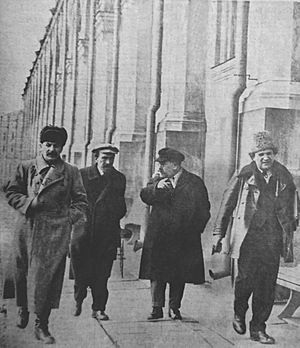
In early 1926, Zinoviev, Kamenev, and their supporters became closer to Trotsky's supporters. The two groups formed an alliance called the United Opposition. During more party fighting between July and October 1926, the United Opposition was defeated. Kamenev lost his Politburo seat at the October meeting.
Kamenev continued to oppose Stalin throughout 1926 and 1927. This led to his removal from the Central Committee in October 1927. After Zinoviev and Trotsky were removed from the Communist Party in November 1927, Kamenev became the main spokesperson for the United Opposition within the Party. He presented their views at the party meeting in December 1927. Kamenev asked for the different groups to make peace. However, his speech was interrupted many times by his opponents, showing that his efforts were useless. The meeting declared that the United Opposition's views were not allowed for party members. Kamenev and many other leading Opposition members were removed from the Party. This led to many ordinary members being removed in 1928.
Kamenev's first marriage ended in divorce in 1928. He then married Tatiana Glebova. They had a son together, Vladimir Glebov (1929–1994).
Submission to Stalin and Execution
While Trotsky remained strongly against Stalin after being removed from the Party and sent into exile, Zinoviev and Kamenev gave in almost immediately. They asked their supporters to do the same. They wrote letters admitting their mistakes and were allowed back into the Communist Party after six months. They never got their Central Committee seats back, but they were given mid-level jobs in the government. Kamenev and Zinoviev were approached by Bukharin in the summer of 1928. Bukharin was starting his own struggle with Stalin. This was reported to Joseph Stalin and used against Bukharin.
Zinoviev and Kamenev stayed out of politics until October 1932. They were removed from the Communist Party again. This happened because they received a message from an opposition group but did not tell the party about it. After admitting their mistakes again, they were allowed back in December 1933. They were forced to give speeches at the 17th Party Congress in January 1934. There, Stalin showed off his former political opponents, making them appear defeated and sorry.

The murder of Sergei Kirov on 1 December 1934 started what are known as Stalin's Great Purges. Stalin began public trials and executions of his opponents. Grigory Zinoviev, Kamenev, and their closest friends were again removed from the Communist Party and arrested.
During this time, Kamenev wrote a letter to Stalin, saying he trusted the party and its leaders. He said he was arrested for connections to people he found "strange and disgusting."
The men were put on trial in January 1935. They were forced to admit they were "morally involved" in Kirov's murder. Zinoviev was sentenced to ten years in prison, and Kamenev to five. Kamenev was charged separately in early 1935 in connection with another case. Although he did not confess, he was sentenced to ten years in prison.
In August 1936, after months of preparation in secret police prisons, Zinoviev, Kamenev, and 14 others were put on trial again. This time, they were accused of forming a terrorist group that supposedly killed Kirov and tried to kill Stalin. This trial, known as the Trial of the Sixteen, was one of the Moscow Show Trials. These trials led to more show trials where people were forced to confess to terrible crimes like spying and sabotage. Like the other defendants, Kamenev was found guilty and executed by a firing squad on 25 August 1936. His body's location is unknown. In 1988, during a time of change called perestroika, Kamenev, Zinoviev, and others were officially cleared of their charges.
Fate of Kamenev's Family
After Kamenev's execution, his family members also faced terrible fates. Kamenev's second son, Yu. L. Kamenev, was executed on 30 January 1938, when he was 17 years old. His oldest son, A.L. Kamenev, an Air Force officer, was executed on 15 July 1939, at age 33. His first wife, Olga, was executed on 11 September 1941, in a forest outside Oryol. Only his youngest son, Vladimir Glebov, survived Stalin's prisons and labor camps, living until 1994.
Images for kids
-
The photo shows the leadership of the USSR: Joseph Stalin, General Secretary of the Communist Party; Alexei Rykov, Chairman of the Council of People's Commissars (Prime Minister); Lev Kamenev, Deputy Chairman of the Council of People's Commissars (Deputy Prime Minister); Grigory Zinoviev, Chairman of the Comintern's Executive Committee. Apr 1925.
-
Bust of Kamenev by Clare Sheridan
See also
 In Spanish: Lev Kámenev para niños
In Spanish: Lev Kámenev para niños


